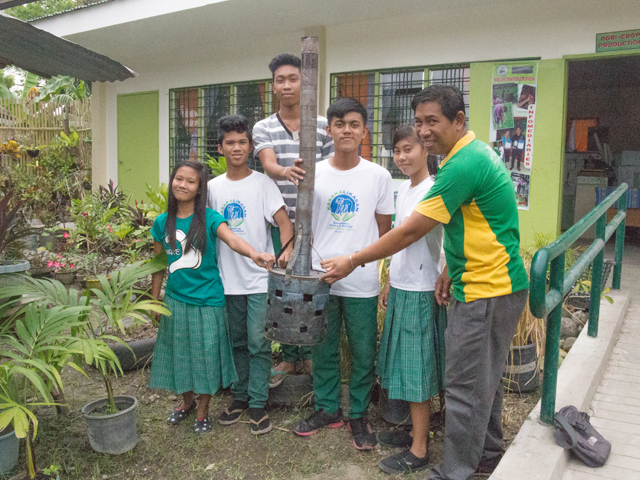 Out of ingenuity and resourcefulness, the Grade 10 students of Baluan National High School (BNHS) in General Santos City fabricated a simple, open-type carbonizer that farming families can duplicate in their own households.
Out of ingenuity and resourcefulness, the Grade 10 students of Baluan National High School (BNHS) in General Santos City fabricated a simple, open-type carbonizer that farming families can duplicate in their own households.
Agri-crop students Joshua Padilla, Jenny Algarme, Arhon James Patricio, Selwyn Luayon, 16, and Amie Lym Dedel, 17, shared that their version of the carbonizer first emerged as a school project after watching a video presentation on the said technology.
“Despite our meager resources, we had to accomplish our school project and produce a carbonizer that we can use for our school’s rice garden,” Algarme shared.
In making the Baluan open-type carbonizer, these young minds recycled 12 pieces of 370-ml milk cans, a 16-L used can of paint or oil, and scrap metal sheets. Additionally, they needed P20 worth of rivet fasteners. Here’s how they did it:
1. For the chamber, they removed one of the covers of the 16-L used can of paint. On the other side, they made a hole with a diameter similar to the milk cans. Using a knife, they also made holes around the chamber, each measuring 4×4 cm. Padilla said that the length of carbonization depends on the size of the holes: the smaller the holes, the slower the carbonization process.
2. For the chimney, they removed both covers of all milk cans and flattened each surface. They slightly compressed one end of each can to ensure that it can be easily inserted into the other. The connected cans looked like a long cylinder, open at both ends.
3. Then, they inserted the chimney into the hole of the chamber.
To make the carbonizer sturdy and durable, they added braces using scrap metal sheets that hold the chimney and the chamber together. Three to four metal sheets were attached with the use of rivet fasteners.
“In 10 min, we can produce three sacks of carbonized rice hull (CRH) from six sacks of rice hull,” Algarme explained.
Taught about the use of CRH in their climate-smart agriculture subject, they used it as soil media in their dapog method of transplanting rice seedlings. They also applied 0.5 kg of CRH in their 1-ha rice field during land preparation.
They found that lifting rice seedlings from the bed applied with CRH was far easier. They also observed the absence of golden apple snail (kuhol). Fredierick Saludez, PhilRice Text Center agent, said that CRH retains heat from the sun owing to its natural black color and contains silica that irritates the said rice pest.
Change makers
Research shows that the Philippines produces about 3.1 MT of rice hull every year. Rice-based farmers and entrepreneurs, however, have limited knowledge on properly managing rice hull; hence, it is wasted.
In Baluan, Padilla observed that farmers and millers either throw away or burn rice hull.
Meanwhile, PhilRice has shown different uses of CRH such as being a substrate to organic fertilizer, a soil conditioner, a water purifier/filter, a base material for making microbial inoculants, a pest control agent, and an odor suppressant.
According to Edmar Juanitez, Technical Vocational teacher at BNHS, the open-type carbonizer that the students innovated was presented during the parent-teachers meeting in their school.
“Some of the parents have shown interest in this innovation, mainly because it is cheap and easy to fabricate. They also became aware that rice hull has plenty of productive uses. A number of our students shared that their farmer-parents are now using the said carbonizer while some are already applying CRH in their farms,” Juanitez said.
These Grade 10 students are participants of the Infomediary Campaign, a collaborative undertaking among PhilRice, DepEd, and Consultative Group on International Agricultural Research Program on Climate Change, Agriculture and Food Security. The Infomediary Campaign aims to mobilize high school students to become agriculture information providers (infomediaries) in their own rural rice-farming communities.




